Financial Reporting Analysis: Differential Reporting in Australia
VerifiedAdded on 2020/03/01
|10
|1802
|45
Report
AI Summary
This report examines financial reporting in Australia, specifically focusing on the Australian Accounting Standards Board (AASB) and its differential reporting framework, which has evolved since 1990. It delves into the shift from the 'Reporting Entity' concept to a more regulatory model, as well as the introduction of a two-tier reporting system (Tier 1 and Tier 2) for General Purpose Financial Reports (GPFR). The report discusses the reduced disclosure requirements (RDR) for Tier 2 entities, the implications of AASB 1053 and AASB 2010-2, and the potential impact on companies, including the elimination of special purpose financial reports. It highlights the importance of compliance with AASB standards, particularly for directors and committee members, and the opportunity for entities to move from special-purpose financial reporting to GPFR. The report also references key sources like AASB publications and academic research on the topic.
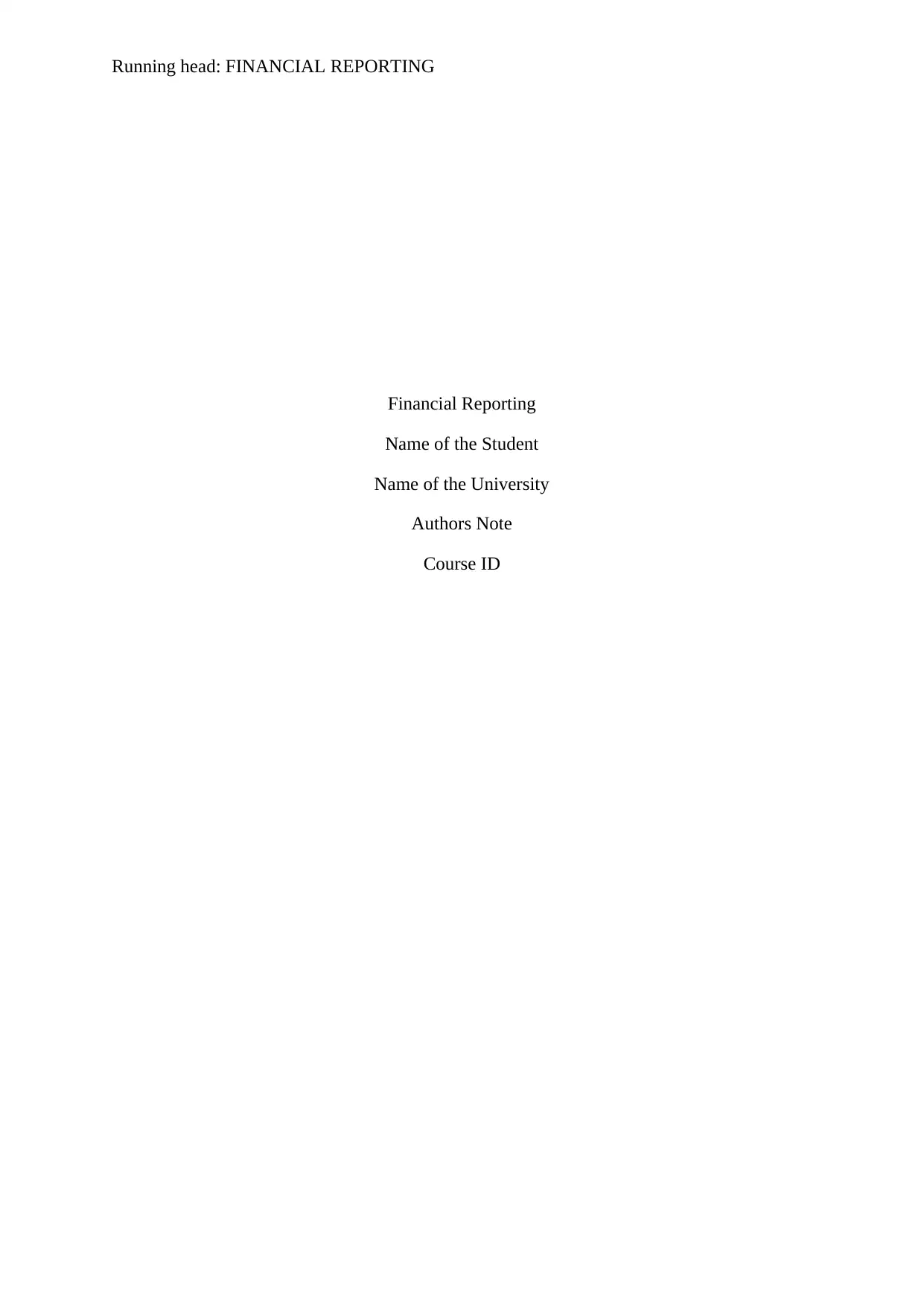
Running head: FINANCIAL REPORTING
Financial Reporting
Name of the Student
Name of the University
Authors Note
Course ID
Financial Reporting
Name of the Student
Name of the University
Authors Note
Course ID
Paraphrase This Document
Need a fresh take? Get an instant paraphrase of this document with our AI Paraphraser
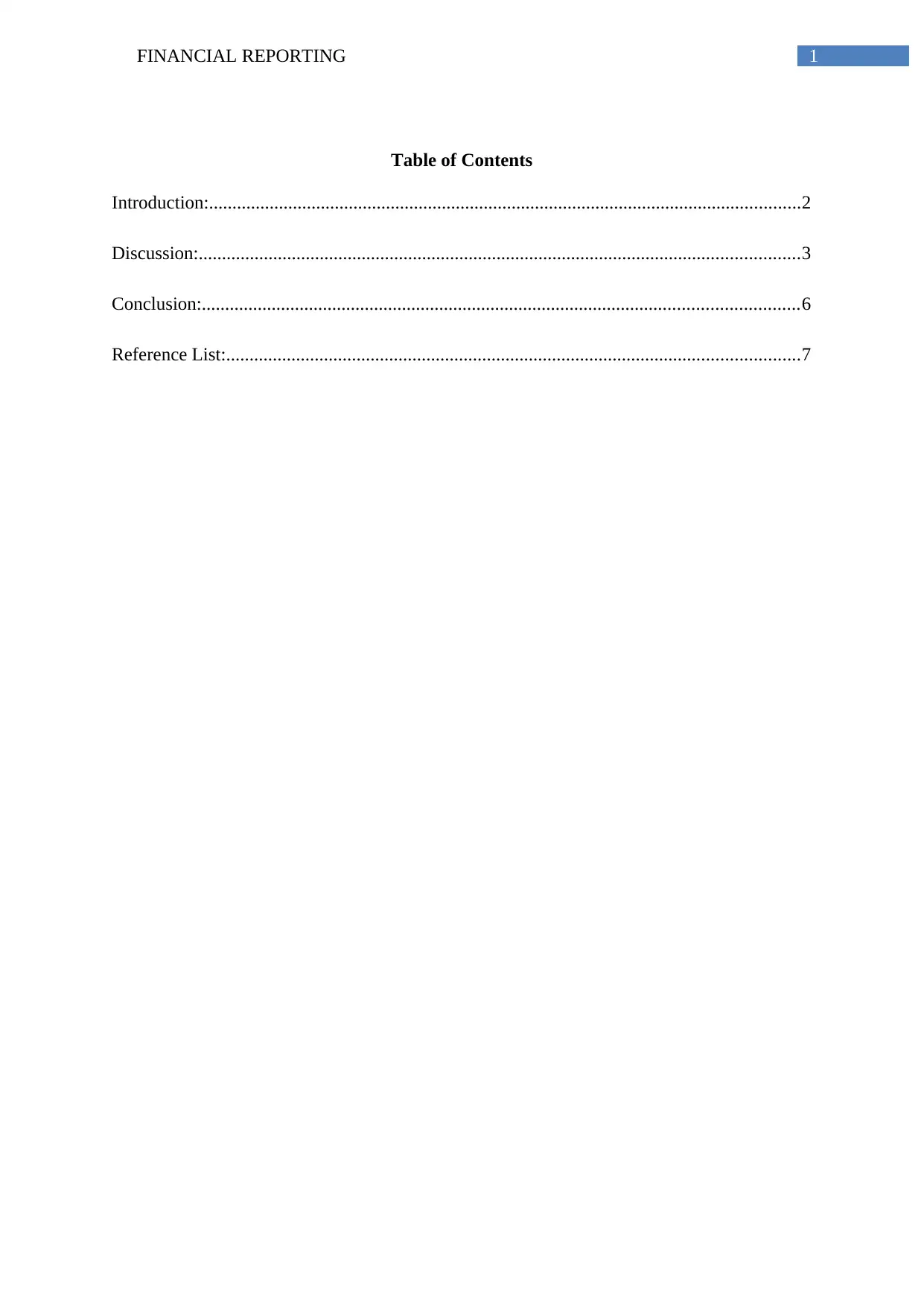
1FINANCIAL REPORTING
Table of Contents
Introduction:...............................................................................................................................2
Discussion:.................................................................................................................................3
Conclusion:................................................................................................................................6
Reference List:...........................................................................................................................7
Table of Contents
Introduction:...............................................................................................................................2
Discussion:.................................................................................................................................3
Conclusion:................................................................................................................................6
Reference List:...........................................................................................................................7
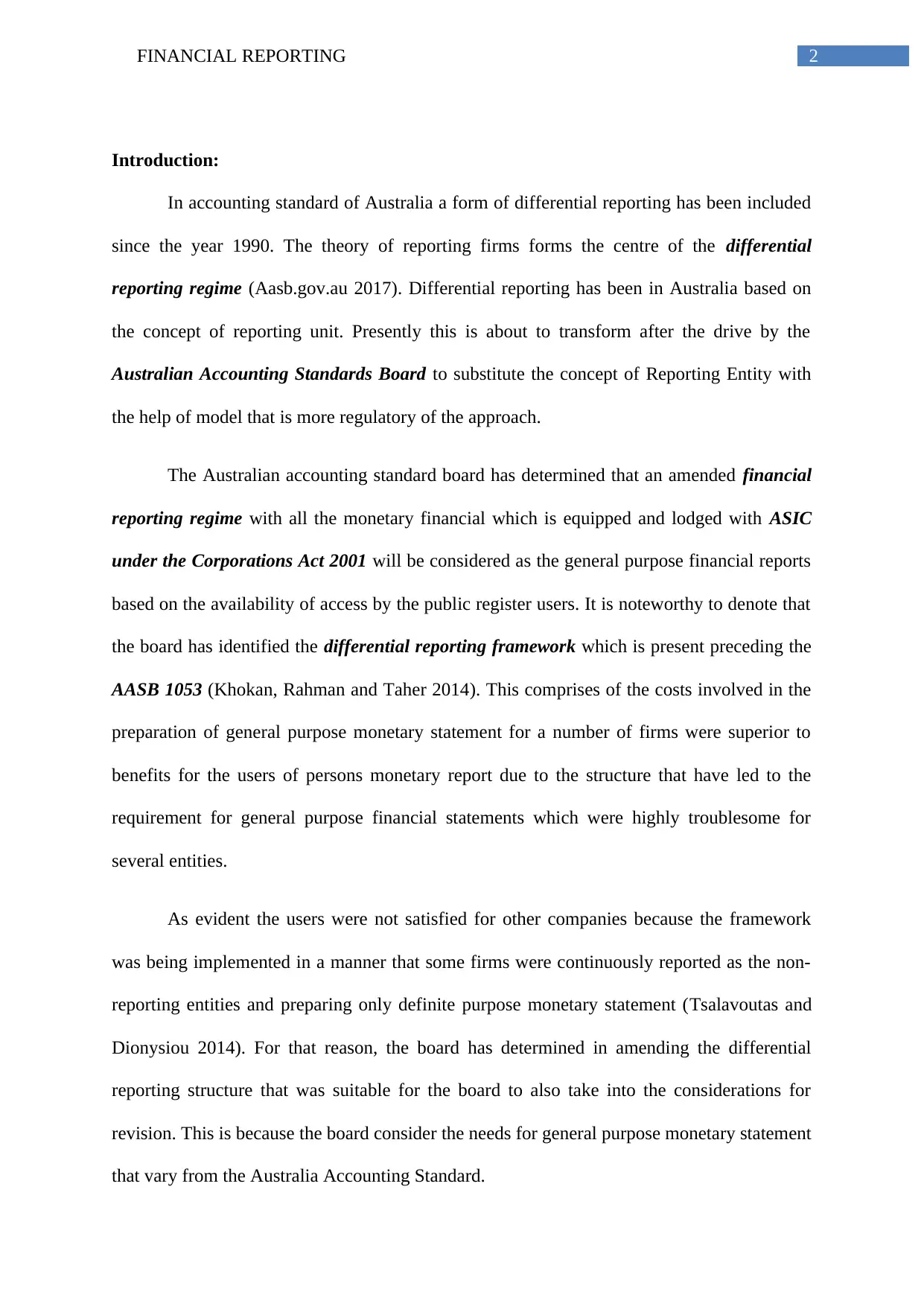
2FINANCIAL REPORTING
Introduction:
In accounting standard of Australia a form of differential reporting has been included
since the year 1990. The theory of reporting firms forms the centre of the differential
reporting regime (Aasb.gov.au 2017). Differential reporting has been in Australia based on
the concept of reporting unit. Presently this is about to transform after the drive by the
Australian Accounting Standards Board to substitute the concept of Reporting Entity with
the help of model that is more regulatory of the approach.
The Australian accounting standard board has determined that an amended financial
reporting regime with all the monetary financial which is equipped and lodged with ASIC
under the Corporations Act 2001 will be considered as the general purpose financial reports
based on the availability of access by the public register users. It is noteworthy to denote that
the board has identified the differential reporting framework which is present preceding the
AASB 1053 (Khokan, Rahman and Taher 2014). This comprises of the costs involved in the
preparation of general purpose monetary statement for a number of firms were superior to
benefits for the users of persons monetary report due to the structure that have led to the
requirement for general purpose financial statements which were highly troublesome for
several entities.
As evident the users were not satisfied for other companies because the framework
was being implemented in a manner that some firms were continuously reported as the non-
reporting entities and preparing only definite purpose monetary statement (Tsalavoutas and
Dionysiou 2014). For that reason, the board has determined in amending the differential
reporting structure that was suitable for the board to also take into the considerations for
revision. This is because the board consider the needs for general purpose monetary statement
that vary from the Australia Accounting Standard.
Introduction:
In accounting standard of Australia a form of differential reporting has been included
since the year 1990. The theory of reporting firms forms the centre of the differential
reporting regime (Aasb.gov.au 2017). Differential reporting has been in Australia based on
the concept of reporting unit. Presently this is about to transform after the drive by the
Australian Accounting Standards Board to substitute the concept of Reporting Entity with
the help of model that is more regulatory of the approach.
The Australian accounting standard board has determined that an amended financial
reporting regime with all the monetary financial which is equipped and lodged with ASIC
under the Corporations Act 2001 will be considered as the general purpose financial reports
based on the availability of access by the public register users. It is noteworthy to denote that
the board has identified the differential reporting framework which is present preceding the
AASB 1053 (Khokan, Rahman and Taher 2014). This comprises of the costs involved in the
preparation of general purpose monetary statement for a number of firms were superior to
benefits for the users of persons monetary report due to the structure that have led to the
requirement for general purpose financial statements which were highly troublesome for
several entities.
As evident the users were not satisfied for other companies because the framework
was being implemented in a manner that some firms were continuously reported as the non-
reporting entities and preparing only definite purpose monetary statement (Tsalavoutas and
Dionysiou 2014). For that reason, the board has determined in amending the differential
reporting structure that was suitable for the board to also take into the considerations for
revision. This is because the board consider the needs for general purpose monetary statement
that vary from the Australia Accounting Standard.
⊘ This is a preview!⊘
Do you want full access?
Subscribe today to unlock all pages.

Trusted by 1+ million students worldwide
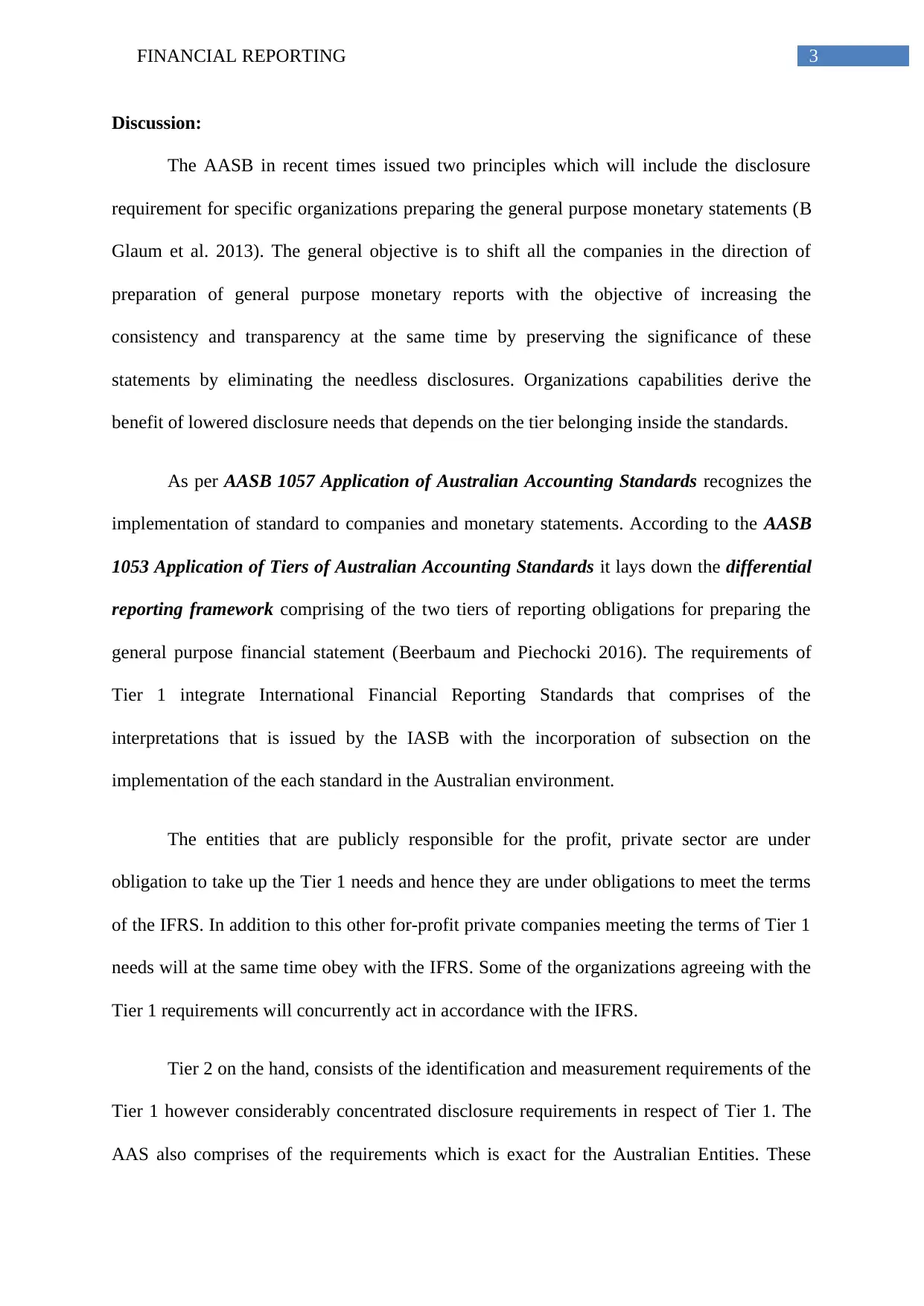
3FINANCIAL REPORTING
Discussion:
The AASB in recent times issued two principles which will include the disclosure
requirement for specific organizations preparing the general purpose monetary statements (B
Glaum et al. 2013). The general objective is to shift all the companies in the direction of
preparation of general purpose monetary reports with the objective of increasing the
consistency and transparency at the same time by preserving the significance of these
statements by eliminating the needless disclosures. Organizations capabilities derive the
benefit of lowered disclosure needs that depends on the tier belonging inside the standards.
As per AASB 1057 Application of Australian Accounting Standards recognizes the
implementation of standard to companies and monetary statements. According to the AASB
1053 Application of Tiers of Australian Accounting Standards it lays down the differential
reporting framework comprising of the two tiers of reporting obligations for preparing the
general purpose financial statement (Beerbaum and Piechocki 2016). The requirements of
Tier 1 integrate International Financial Reporting Standards that comprises of the
interpretations that is issued by the IASB with the incorporation of subsection on the
implementation of the each standard in the Australian environment.
The entities that are publicly responsible for the profit, private sector are under
obligation to take up the Tier 1 needs and hence they are under obligations to meet the terms
of the IFRS. In addition to this other for-profit private companies meeting the terms of Tier 1
needs will at the same time obey with the IFRS. Some of the organizations agreeing with the
Tier 1 requirements will concurrently act in accordance with the IFRS.
Tier 2 on the hand, consists of the identification and measurement requirements of the
Tier 1 however considerably concentrated disclosure requirements in respect of Tier 1. The
AAS also comprises of the requirements which is exact for the Australian Entities. These
Discussion:
The AASB in recent times issued two principles which will include the disclosure
requirement for specific organizations preparing the general purpose monetary statements (B
Glaum et al. 2013). The general objective is to shift all the companies in the direction of
preparation of general purpose monetary reports with the objective of increasing the
consistency and transparency at the same time by preserving the significance of these
statements by eliminating the needless disclosures. Organizations capabilities derive the
benefit of lowered disclosure needs that depends on the tier belonging inside the standards.
As per AASB 1057 Application of Australian Accounting Standards recognizes the
implementation of standard to companies and monetary statements. According to the AASB
1053 Application of Tiers of Australian Accounting Standards it lays down the differential
reporting framework comprising of the two tiers of reporting obligations for preparing the
general purpose financial statement (Beerbaum and Piechocki 2016). The requirements of
Tier 1 integrate International Financial Reporting Standards that comprises of the
interpretations that is issued by the IASB with the incorporation of subsection on the
implementation of the each standard in the Australian environment.
The entities that are publicly responsible for the profit, private sector are under
obligation to take up the Tier 1 needs and hence they are under obligations to meet the terms
of the IFRS. In addition to this other for-profit private companies meeting the terms of Tier 1
needs will at the same time obey with the IFRS. Some of the organizations agreeing with the
Tier 1 requirements will concurrently act in accordance with the IFRS.
Tier 2 on the hand, consists of the identification and measurement requirements of the
Tier 1 however considerably concentrated disclosure requirements in respect of Tier 1. The
AAS also comprises of the requirements which is exact for the Australian Entities. These
Paraphrase This Document
Need a fresh take? Get an instant paraphrase of this document with our AI Paraphraser
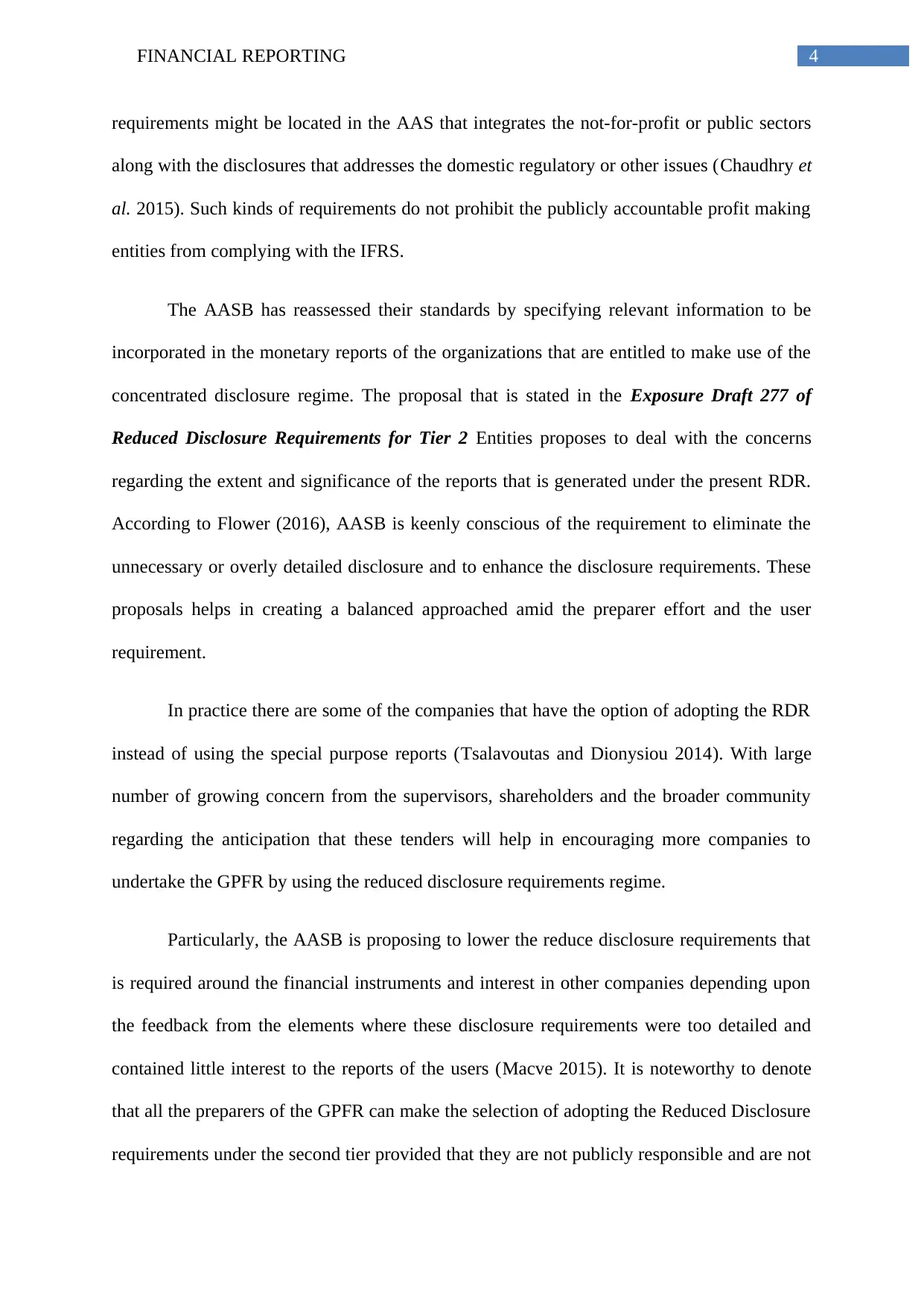
4FINANCIAL REPORTING
requirements might be located in the AAS that integrates the not-for-profit or public sectors
along with the disclosures that addresses the domestic regulatory or other issues (Chaudhry et
al. 2015). Such kinds of requirements do not prohibit the publicly accountable profit making
entities from complying with the IFRS.
The AASB has reassessed their standards by specifying relevant information to be
incorporated in the monetary reports of the organizations that are entitled to make use of the
concentrated disclosure regime. The proposal that is stated in the Exposure Draft 277 of
Reduced Disclosure Requirements for Tier 2 Entities proposes to deal with the concerns
regarding the extent and significance of the reports that is generated under the present RDR.
According to Flower (2016), AASB is keenly conscious of the requirement to eliminate the
unnecessary or overly detailed disclosure and to enhance the disclosure requirements. These
proposals helps in creating a balanced approached amid the preparer effort and the user
requirement.
In practice there are some of the companies that have the option of adopting the RDR
instead of using the special purpose reports (Tsalavoutas and Dionysiou 2014). With large
number of growing concern from the supervisors, shareholders and the broader community
regarding the anticipation that these tenders will help in encouraging more companies to
undertake the GPFR by using the reduced disclosure requirements regime.
Particularly, the AASB is proposing to lower the reduce disclosure requirements that
is required around the financial instruments and interest in other companies depending upon
the feedback from the elements where these disclosure requirements were too detailed and
contained little interest to the reports of the users (Macve 2015). It is noteworthy to denote
that all the preparers of the GPFR can make the selection of adopting the Reduced Disclosure
requirements under the second tier provided that they are not publicly responsible and are not
requirements might be located in the AAS that integrates the not-for-profit or public sectors
along with the disclosures that addresses the domestic regulatory or other issues (Chaudhry et
al. 2015). Such kinds of requirements do not prohibit the publicly accountable profit making
entities from complying with the IFRS.
The AASB has reassessed their standards by specifying relevant information to be
incorporated in the monetary reports of the organizations that are entitled to make use of the
concentrated disclosure regime. The proposal that is stated in the Exposure Draft 277 of
Reduced Disclosure Requirements for Tier 2 Entities proposes to deal with the concerns
regarding the extent and significance of the reports that is generated under the present RDR.
According to Flower (2016), AASB is keenly conscious of the requirement to eliminate the
unnecessary or overly detailed disclosure and to enhance the disclosure requirements. These
proposals helps in creating a balanced approached amid the preparer effort and the user
requirement.
In practice there are some of the companies that have the option of adopting the RDR
instead of using the special purpose reports (Tsalavoutas and Dionysiou 2014). With large
number of growing concern from the supervisors, shareholders and the broader community
regarding the anticipation that these tenders will help in encouraging more companies to
undertake the GPFR by using the reduced disclosure requirements regime.
Particularly, the AASB is proposing to lower the reduce disclosure requirements that
is required around the financial instruments and interest in other companies depending upon
the feedback from the elements where these disclosure requirements were too detailed and
contained little interest to the reports of the users (Macve 2015). It is noteworthy to denote
that all the preparers of the GPFR can make the selection of adopting the Reduced Disclosure
requirements under the second tier provided that they are not publicly responsible and are not
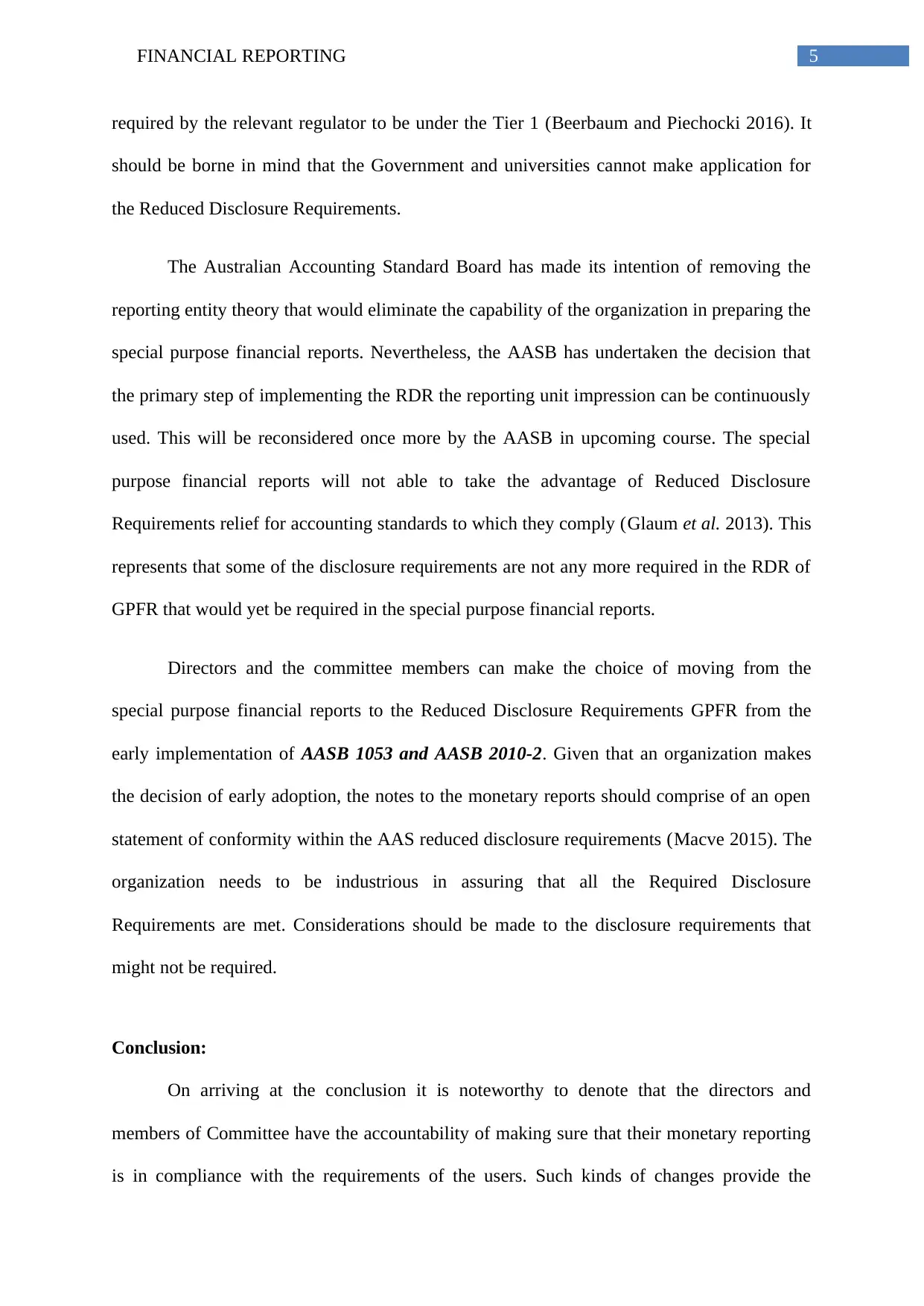
5FINANCIAL REPORTING
required by the relevant regulator to be under the Tier 1 (Beerbaum and Piechocki 2016). It
should be borne in mind that the Government and universities cannot make application for
the Reduced Disclosure Requirements.
The Australian Accounting Standard Board has made its intention of removing the
reporting entity theory that would eliminate the capability of the organization in preparing the
special purpose financial reports. Nevertheless, the AASB has undertaken the decision that
the primary step of implementing the RDR the reporting unit impression can be continuously
used. This will be reconsidered once more by the AASB in upcoming course. The special
purpose financial reports will not able to take the advantage of Reduced Disclosure
Requirements relief for accounting standards to which they comply (Glaum et al. 2013). This
represents that some of the disclosure requirements are not any more required in the RDR of
GPFR that would yet be required in the special purpose financial reports.
Directors and the committee members can make the choice of moving from the
special purpose financial reports to the Reduced Disclosure Requirements GPFR from the
early implementation of AASB 1053 and AASB 2010-2. Given that an organization makes
the decision of early adoption, the notes to the monetary reports should comprise of an open
statement of conformity within the AAS reduced disclosure requirements (Macve 2015). The
organization needs to be industrious in assuring that all the Required Disclosure
Requirements are met. Considerations should be made to the disclosure requirements that
might not be required.
Conclusion:
On arriving at the conclusion it is noteworthy to denote that the directors and
members of Committee have the accountability of making sure that their monetary reporting
is in compliance with the requirements of the users. Such kinds of changes provide the
required by the relevant regulator to be under the Tier 1 (Beerbaum and Piechocki 2016). It
should be borne in mind that the Government and universities cannot make application for
the Reduced Disclosure Requirements.
The Australian Accounting Standard Board has made its intention of removing the
reporting entity theory that would eliminate the capability of the organization in preparing the
special purpose financial reports. Nevertheless, the AASB has undertaken the decision that
the primary step of implementing the RDR the reporting unit impression can be continuously
used. This will be reconsidered once more by the AASB in upcoming course. The special
purpose financial reports will not able to take the advantage of Reduced Disclosure
Requirements relief for accounting standards to which they comply (Glaum et al. 2013). This
represents that some of the disclosure requirements are not any more required in the RDR of
GPFR that would yet be required in the special purpose financial reports.
Directors and the committee members can make the choice of moving from the
special purpose financial reports to the Reduced Disclosure Requirements GPFR from the
early implementation of AASB 1053 and AASB 2010-2. Given that an organization makes
the decision of early adoption, the notes to the monetary reports should comprise of an open
statement of conformity within the AAS reduced disclosure requirements (Macve 2015). The
organization needs to be industrious in assuring that all the Required Disclosure
Requirements are met. Considerations should be made to the disclosure requirements that
might not be required.
Conclusion:
On arriving at the conclusion it is noteworthy to denote that the directors and
members of Committee have the accountability of making sure that their monetary reporting
is in compliance with the requirements of the users. Such kinds of changes provide the
⊘ This is a preview!⊘
Do you want full access?
Subscribe today to unlock all pages.

Trusted by 1+ million students worldwide
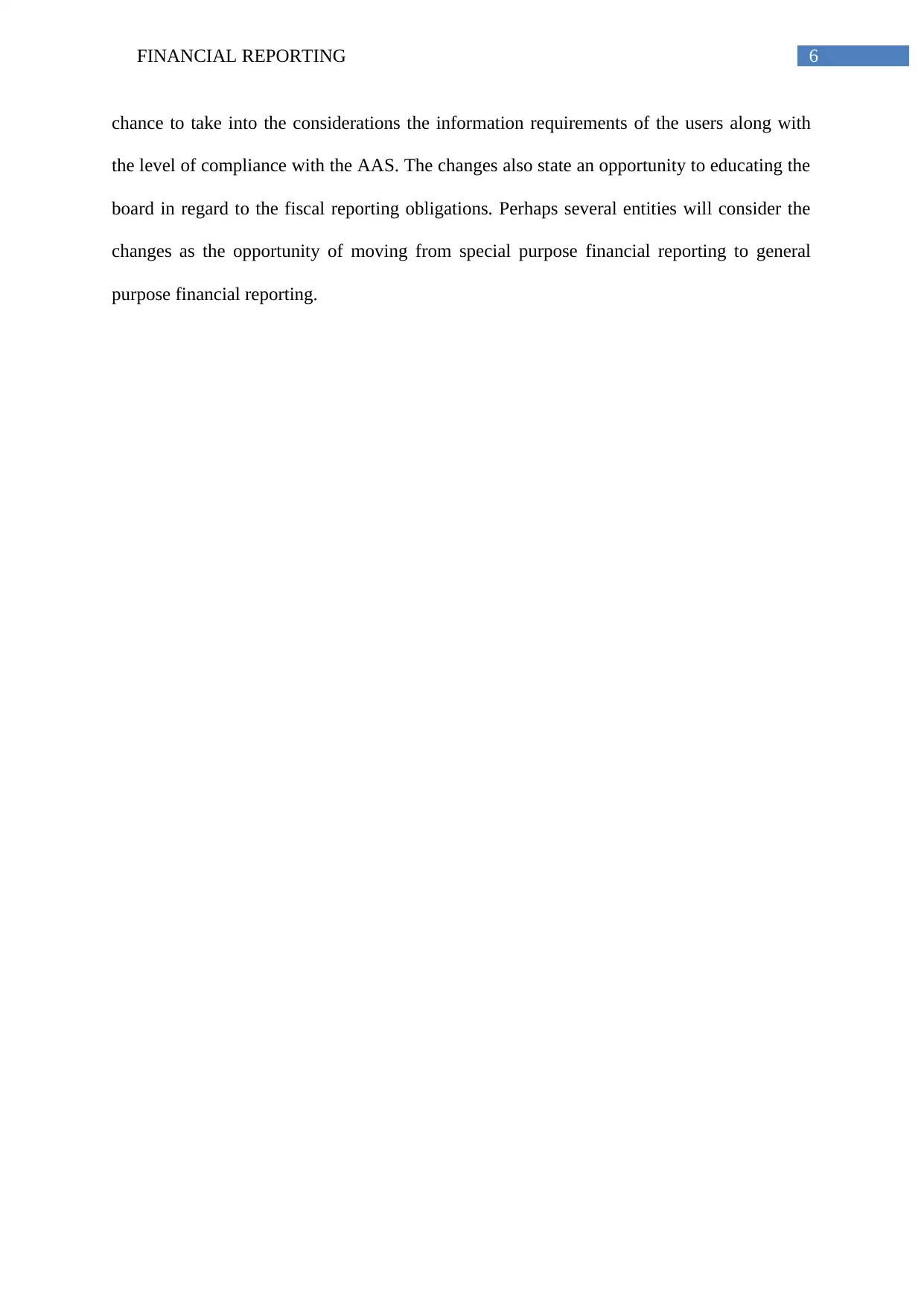
6FINANCIAL REPORTING
chance to take into the considerations the information requirements of the users along with
the level of compliance with the AAS. The changes also state an opportunity to educating the
board in regard to the fiscal reporting obligations. Perhaps several entities will consider the
changes as the opportunity of moving from special purpose financial reporting to general
purpose financial reporting.
chance to take into the considerations the information requirements of the users along with
the level of compliance with the AAS. The changes also state an opportunity to educating the
board in regard to the fiscal reporting obligations. Perhaps several entities will consider the
changes as the opportunity of moving from special purpose financial reporting to general
purpose financial reporting.
Paraphrase This Document
Need a fresh take? Get an instant paraphrase of this document with our AI Paraphraser
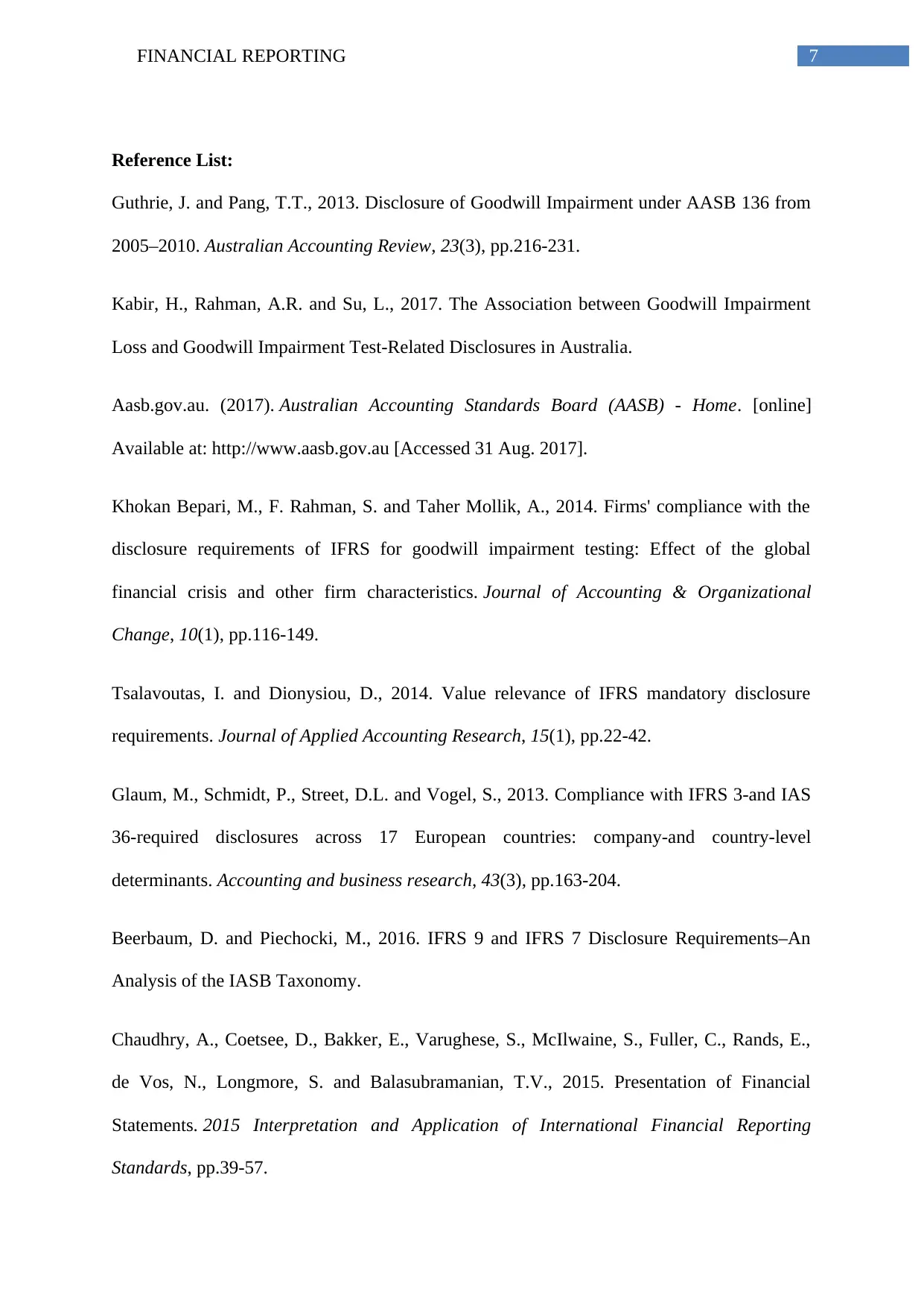
7FINANCIAL REPORTING
Reference List:
Guthrie, J. and Pang, T.T., 2013. Disclosure of Goodwill Impairment under AASB 136 from
2005–2010. Australian Accounting Review, 23(3), pp.216-231.
Kabir, H., Rahman, A.R. and Su, L., 2017. The Association between Goodwill Impairment
Loss and Goodwill Impairment Test-Related Disclosures in Australia.
Aasb.gov.au. (2017). Australian Accounting Standards Board (AASB) - Home. [online]
Available at: http://www.aasb.gov.au [Accessed 31 Aug. 2017].
Khokan Bepari, M., F. Rahman, S. and Taher Mollik, A., 2014. Firms' compliance with the
disclosure requirements of IFRS for goodwill impairment testing: Effect of the global
financial crisis and other firm characteristics. Journal of Accounting & Organizational
Change, 10(1), pp.116-149.
Tsalavoutas, I. and Dionysiou, D., 2014. Value relevance of IFRS mandatory disclosure
requirements. Journal of Applied Accounting Research, 15(1), pp.22-42.
Glaum, M., Schmidt, P., Street, D.L. and Vogel, S., 2013. Compliance with IFRS 3-and IAS
36-required disclosures across 17 European countries: company-and country-level
determinants. Accounting and business research, 43(3), pp.163-204.
Beerbaum, D. and Piechocki, M., 2016. IFRS 9 and IFRS 7 Disclosure Requirements–An
Analysis of the IASB Taxonomy.
Chaudhry, A., Coetsee, D., Bakker, E., Varughese, S., McIlwaine, S., Fuller, C., Rands, E.,
de Vos, N., Longmore, S. and Balasubramanian, T.V., 2015. Presentation of Financial
Statements. 2015 Interpretation and Application of International Financial Reporting
Standards, pp.39-57.
Reference List:
Guthrie, J. and Pang, T.T., 2013. Disclosure of Goodwill Impairment under AASB 136 from
2005–2010. Australian Accounting Review, 23(3), pp.216-231.
Kabir, H., Rahman, A.R. and Su, L., 2017. The Association between Goodwill Impairment
Loss and Goodwill Impairment Test-Related Disclosures in Australia.
Aasb.gov.au. (2017). Australian Accounting Standards Board (AASB) - Home. [online]
Available at: http://www.aasb.gov.au [Accessed 31 Aug. 2017].
Khokan Bepari, M., F. Rahman, S. and Taher Mollik, A., 2014. Firms' compliance with the
disclosure requirements of IFRS for goodwill impairment testing: Effect of the global
financial crisis and other firm characteristics. Journal of Accounting & Organizational
Change, 10(1), pp.116-149.
Tsalavoutas, I. and Dionysiou, D., 2014. Value relevance of IFRS mandatory disclosure
requirements. Journal of Applied Accounting Research, 15(1), pp.22-42.
Glaum, M., Schmidt, P., Street, D.L. and Vogel, S., 2013. Compliance with IFRS 3-and IAS
36-required disclosures across 17 European countries: company-and country-level
determinants. Accounting and business research, 43(3), pp.163-204.
Beerbaum, D. and Piechocki, M., 2016. IFRS 9 and IFRS 7 Disclosure Requirements–An
Analysis of the IASB Taxonomy.
Chaudhry, A., Coetsee, D., Bakker, E., Varughese, S., McIlwaine, S., Fuller, C., Rands, E.,
de Vos, N., Longmore, S. and Balasubramanian, T.V., 2015. Presentation of Financial
Statements. 2015 Interpretation and Application of International Financial Reporting
Standards, pp.39-57.
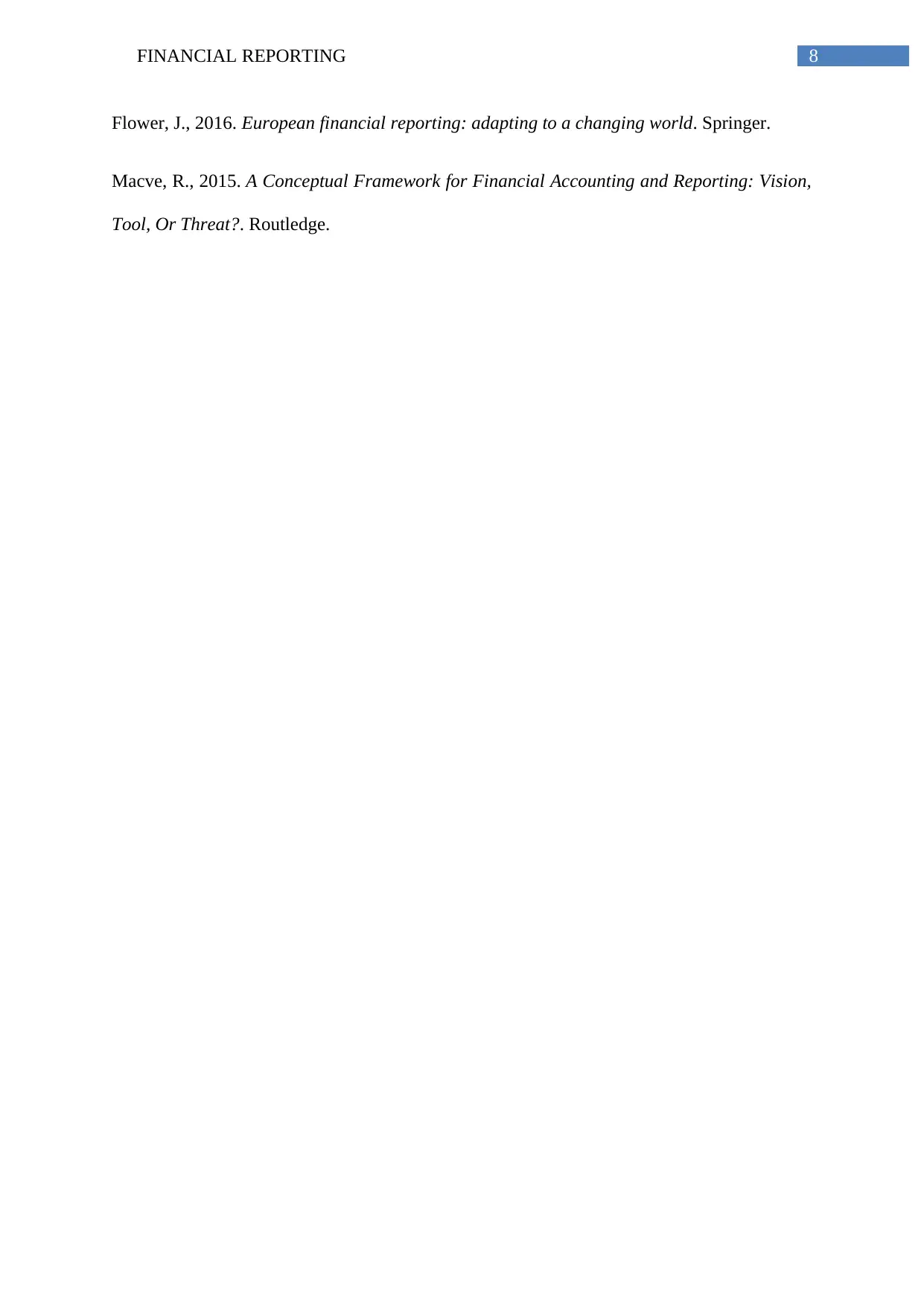
8FINANCIAL REPORTING
Flower, J., 2016. European financial reporting: adapting to a changing world. Springer.
Macve, R., 2015. A Conceptual Framework for Financial Accounting and Reporting: Vision,
Tool, Or Threat?. Routledge.
Flower, J., 2016. European financial reporting: adapting to a changing world. Springer.
Macve, R., 2015. A Conceptual Framework for Financial Accounting and Reporting: Vision,
Tool, Or Threat?. Routledge.
⊘ This is a preview!⊘
Do you want full access?
Subscribe today to unlock all pages.

Trusted by 1+ million students worldwide
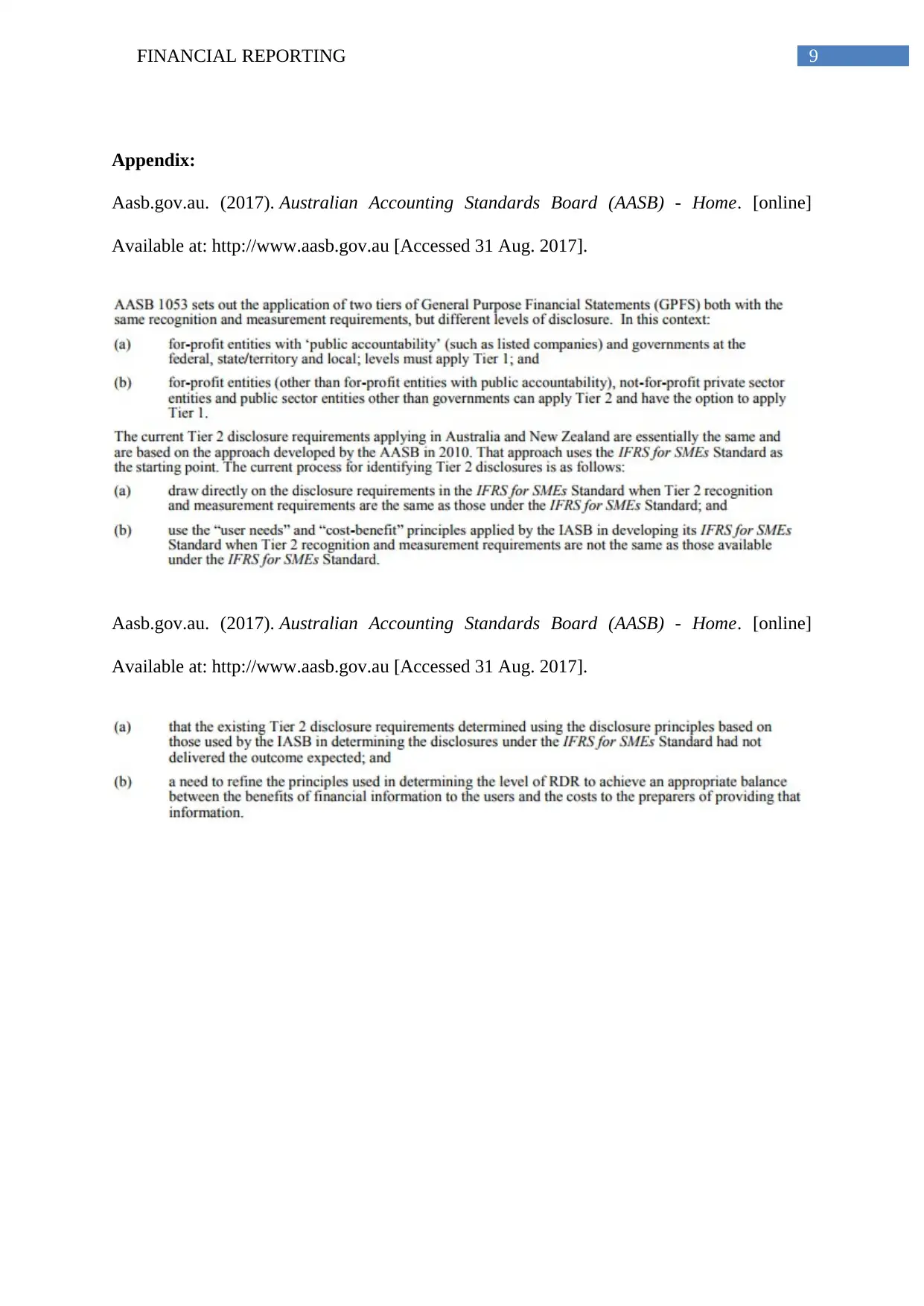
9FINANCIAL REPORTING
Appendix:
Aasb.gov.au. (2017). Australian Accounting Standards Board (AASB) - Home. [online]
Available at: http://www.aasb.gov.au [Accessed 31 Aug. 2017].
Aasb.gov.au. (2017). Australian Accounting Standards Board (AASB) - Home. [online]
Available at: http://www.aasb.gov.au [Accessed 31 Aug. 2017].
Appendix:
Aasb.gov.au. (2017). Australian Accounting Standards Board (AASB) - Home. [online]
Available at: http://www.aasb.gov.au [Accessed 31 Aug. 2017].
Aasb.gov.au. (2017). Australian Accounting Standards Board (AASB) - Home. [online]
Available at: http://www.aasb.gov.au [Accessed 31 Aug. 2017].
1 out of 10
Related Documents
Your All-in-One AI-Powered Toolkit for Academic Success.
+13062052269
info@desklib.com
Available 24*7 on WhatsApp / Email
![[object Object]](/_next/static/media/star-bottom.7253800d.svg)
Unlock your academic potential
Copyright © 2020–2025 A2Z Services. All Rights Reserved. Developed and managed by ZUCOL.





